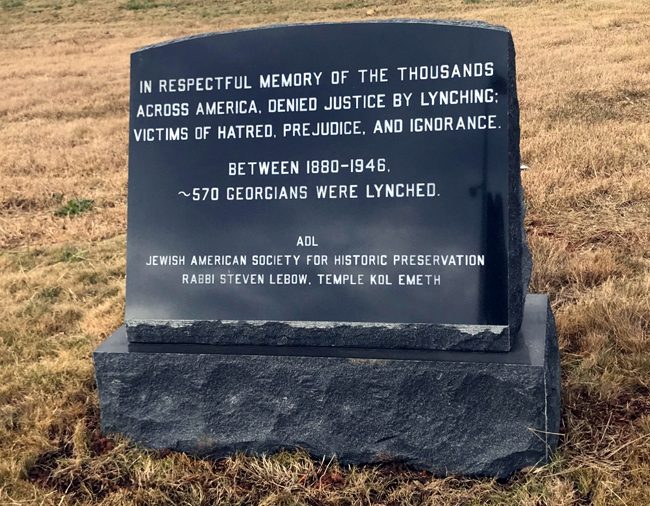
BOYNTON BEACH, Florida — In respectful and honored tribute to Congressman John Lewis:
August 17, 1915, Atlanta, Georgia Jewish businessman, and President of B’nai Brith, Leo Frank was lynched before an eager audience of hundreds for the rape and murder of 13-year-old Mary Phagan.
Frank was convicted by circumstantial evidence after a nationally sensationalized trial, seriously tainted by racism and anti-Semitism.
Frank was sentenced to death.
Governor John Slaton was deeply troubled by the evidence. He, at great risk to himself, commuted Frank’s sentence to life in prison.
The mob, inflamed by media, bigotry, and hate, led by founding members of the Ku Klux Klan, kidnapped Frank from his prison cell. He was taken to Phagan’s hometown of Marietta, outside of Atlanta.
Leo Frank was lynched. The body was taken to New York for burial. A foot stone was placed at his grave. Semper Idem…Always the Same.
Atlanta Jews were beyond terrified. The lynching of Frank was not “popular justice” against Frank. It was a message to the Jews. The Jews remained frightened for generations; until memory had dulled. The perpetrators and those who lived the events have long passed.
Today, few Jews know Leo’s story. It is uncomfortable.
Just because Leo’s memory is uncomfortable, that is not a good reason to forget it.
We shape the future by remembering the past.
The Jewish American Society for Historic Preservation (JASHP) undertook the responsibility to preserve the Leo Frank lynching site. We learned the historic site was going to become an off-ramp for a major highway, I-75.
Funding and placing a Georgia Historical Society (GHS) marker at a historic site, under Georgia law, required, after all site redevelopment was completed, the original marker to be restored to an appropriate nearby location
JASHP funded and placed a GHS marker at the Leo Frank lynching site.
2014, the Georgia Department of Transportation (GDOT) began redevelopment of the area. The tree Leo was hung from was removed. Everything at the site was plowed under.
Four years later, 2018, the redevelopment work was completed. The GHS roadside marker for Leo Frank was re-sited next to the off-ramp. The tiny piece of land allocated for the marker was recognized as the Leo Frank Memorial by GDOT.
JASHP saw, even after being given the moniker of the Leo Frank Memorial by GDOT, the Leo Frank story had become just another marker.
What needed to be memorialized and interpreted was more than the lynching of Leo Frank. Lynching itself needed to be memorialized, interpreted. The Leo Frank marker site was an opportunity to do something of national significance.
JASHP came up with the idea of placing the first National Anti-Lynching Memorial in the country at the Leo Frank site. A National Memorial to all victims of lynching had never been done anywhere.
The land to place the Memorial was small. It was controlled by GDOT. The memorial would need GDOT approval to be added to the Leo Frank Memorial site.
JASHP created, and designed, a size appropriate black granite memorial. Text was written.
“In respectful memory of the thousands
across America, denied justice by lynching;
victims of hatred, prejudice, and ignorance….
Between 1880-1946
~570 Georgians were lynched.”
JASHP provided the funding. The ADL, the local community were brought together. Letters of support were obtained.
GDOT reviewed the Anti-Lynching Memorial request and turned it down. They objected to the size and the design.
The Memorial was re-designed. The application was resubmitted. It was rejected again.
Frustrated, but not finished, JASHP turned to local Georgia Congressman John Lewis for help.
Congressman Lewis wrote to GDOT. He diplomatically asked they reconsider.
“Dear Commissioner McMurry,
I respectfully write to urge the Georgia Department of Transportation to reconsider its decision to deny the placement of the Anti-Lynching Memorial at the Leo Frank Memorial Site.
On August 17, 1915, a mob – imbued with racism and antisemitism – attacked and killed Mr. Frank. His lynching was a horrific denial of justice and a stain on our region and State’s history. It is difficult to explain how significant and impactful it will be to have such a tribute at the newly named Leo Frank Memorial.
Our nation is steadily moving forward in an attempt to erase the pain caused by hate and the injustices based on racism and fear. In 2005, the United States Senate unanimously adopted a resolution to apologize for dark legacy of lynching on our nation’s history. Earlier this year, Members of Congress proposed bipartisan legislation to provide justice for past victims and to clarify and codify the enforcement standards should lynching occur in our future.
For Metro Atlanta and the State of Georgia, the proposed Anti-Lynching Memorial is an important step towards healing for our community and honoring the work and sacrifice of countless generations to end racial and civil injustice in our great country. It is my understanding that there is minimal cost to taxpayers for the proposed Anti-Lynching memorial since the Jewish American Society for Historic Preservation, the Anti-Defamation League, Georgia Jewish civic groups, and many individuals designed and funded this public tribute.
“I hope that the Georgia Department of Transportation will allow this memorial to call the new Leo Frank Memorial home. It will represent Georgia Department of Transportation’s appreciation of the Leo Frank Memorial and its significance to our unified efforts to achieve a Beloved Community.”
Sincerely,
John Lewis
Member of Congress”
GDOT reconsidered. The Memorial was approved.
The first National Anti-Lynching Memorial in the United States was placed at the Leo Frank Memorial site.
The word lynching is misunderstood. Lynching can be extra-judicial hanging, but lynching can also be shooting, burning, or most any violence that can induce terror with its targeted community.
Lynching is used to terrorize for social, political, and economic reasons.
Nationally, about 6,000 lynch victims have been documented. 2/3 of documented lynching victims were Black Americans. 1/3 of lynch victims have been Yellow, Brown, and White.
Lynching is not always White on Black crime. Blacks have lynched Blacks. During the 1891 riots in New Orleans, the single worst mass lynching event occurred, 11 Sicilians were lynched.
Native Americans are not included in the statistics of lynching. Howeer, uncounted millions of Native Americans have been lynching victims.
The National Anti-Lynching Memorial could not have been done without Congressman Lewis.
The Memorial is about what was, not what has to be.
The future is up to us.
*
Jerry Klinger is the President of the Jewish American Society for Historic Preservation, www.JASHP.org
